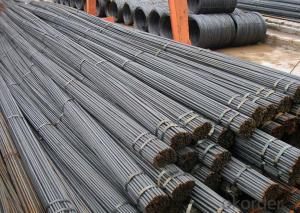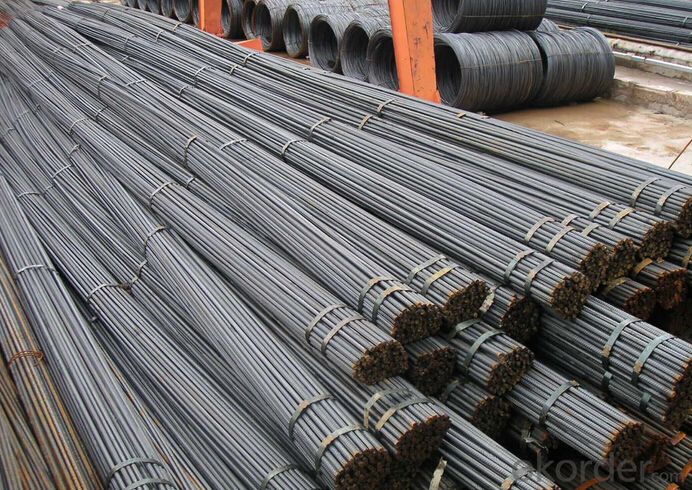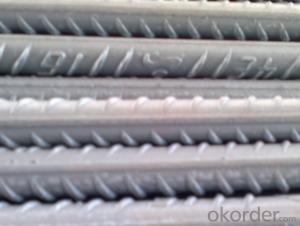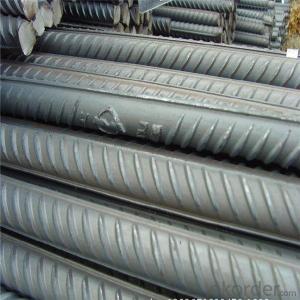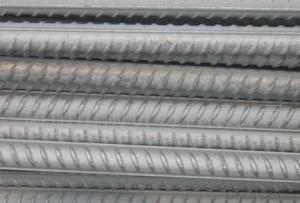Iron Rods For Construction/Concrete Material
- Loading Port:
- Tianjin
- Payment Terms:
- TT OR LC
- Min Order Qty:
- 100 m.t.
- Supply Capability:
- 10000 m.t./month
OKorder Service Pledge
Quality Product, Order Online Tracking, Timely Delivery
OKorder Financial Service
Credit Rating, Credit Services, Credit Purchasing
You Might Also Like
Specification
Standard:
AISI,JIS,GB,BS,DIN,API,EN,ASTM
Technique:
Hot Rolled,Cold Rolled,Cold Drawn,ERW,Forged,Saw,Extruded,EFW,Spring
Shape:
U Channel,Square,C Channel,Hexagonal,Round,Rectangular,Oval,LTZ
Surface Treatment:
Galvanized,Coated,Copper Coated,Color Coated,Oiled,Dry,Chromed Passivation,Polished,Bright,Black,PVDF Coated
Steel Grade:
Q195,Q215,Q235,Q215B,Q235B,RHB335,HRB400,200 Series,300 Series,400 Series,600 Series,SS400-SS490,10#,20#,A53(A,B)
Certification:
ISO,SGS,BV,IBR,RoHS,CE,API,BSI,UL
Thickness:
8-32
Length:
12
Net Weight:
10
Iron Rods For Construction/Concrete Material
Iron Rods For Construction/Concrete Material
| Standard & Grade: | GB1499-98 : HRB335,HRB400,HRB500 |
| BS4449-1997 : GR460,GR500 | |
| CAN/CSA-G30.18-M92 : 400W | |
| ASTM A615 : Gr.40, Gr.60 | |
| Diameter: | 6mm;8mm;10mm;12mm;14mm;16mm;18mm;20mm;22mm;25mm;28mm;30mm;32mm;35mm;40mm |
| Length: | 6m,9m,12m |
| Packing: | Bundle packing |
| Origin: | China |
| Application: | Construction,Road,Machinery processing,Welding fields. |
| Delivery time: | 10-25 days |
| Shipment: | By bulk vessel or Container |
| Documents: | Mill Test Certificate,Commercial Invoice,Packing List,Certificate of Origin |
Company Introduction of the Iron Rods For Construction/Concrete Material
CNBM International Corporation is the most import and export platform of CNBM group(China National Building Material Group Corporation) ,which is a state-owned enterprise, ranked in 270th of Fortune Global 500 in 2015.
With its advantages, CNBM International are mainly concentrate on Cement, Glass, Iron and Steel, Ceramics industries and devotes herself for supplying high quality series of refractories as well as technical consultancies and logistics solution.


Packaging & Delivery of the Iron Rods For Construction/Concrete Material
| Packaging Detail | Sea worthy packing /as per customer's packing instruction |
| Delivery Detail | 15 ~ 40 days after receiving the deposit |
FAQ
| Are you a trading company or manufacturer? | Manufacturer |
| What’s the MOQ? | 1000m2 |
| What’s your delivery time? | 15-20 days after downpayment received |
| Do you Accept OEM service? | Yes |
| what’s your delivery terms? | FOB/CFR/CIF |
| What's the Payment Terms? | 30% as deposit,70% before shipment by T/T |
| Western Union acceptable for small amount. | |
| L/C acceptable for large amount. | |
| Scrow ,Paybal,Alipay are also ok | |
| Why choose us? | Chose happens because of quality, then price, We can give you both. Additionally, we can also offer professional products inquiry, products knowledge train (for agents), smooth goods delivery, excellent customer solution proposals. |
| What's your available port of Shipment? | Main Port, China |
| What’s your featured services? | Our service formula: good quality+ good price+ good service=customer's trust |
| Where are your Market? | Covering more than 160 countries in the world |
- Q: Why do stirrups have thread stirrups and round bars? When are they used?
- Hello, you say the problem is not what time, but the design requirements in that place, accept the stirrup size number with different encryption and so on, have a certain standard, the general drawings above have detailed instructions
- Q: How do steel rebars affect the constructability of a project?
- Steel rebars play a crucial role in enhancing the constructability of a project in several ways. Firstly, they provide structural strength and stability to reinforced concrete structures. By reinforcing the concrete, rebars help to distribute the load more evenly, increasing the overall strength and durability of the project. Secondly, steel rebars allow for the construction of larger and taller structures. They provide the necessary tensile strength to counteract the concrete's weakness in resisting tension forces. This enables engineers and architects to design and build structures with greater flexibility, leading to more innovative and impressive architectural designs. Moreover, steel rebars help to ensure the integrity and safety of a project. They act as a reinforcement against external forces such as earthquakes, wind loads, and impacts. By resisting these forces, they enhance the structural stability, reducing the risk of collapse or damage during extreme conditions. Steel rebars also contribute to the longevity and maintenance of the project. Due to their high tensile strength and resistance to corrosion, they help extend the lifespan of the structure. This reduces the need for frequent repairs and replacements, resulting in cost savings and less disruption to the project. Furthermore, the use of steel rebars simplifies the construction process. They can be easily cut, bent, and shaped to fit the required specifications, making them highly adaptable to various project requirements. This flexibility allows for efficient construction, reducing the time and effort required for implementation. Overall, steel rebars significantly impact the constructability of a project by providing strength, stability, flexibility, safety, longevity, and simplification. Their use enables the construction of robust and aesthetically pleasing structures, ensuring the success and sustainability of the project.
- Q: What is the average lifespan of steel rebars in a structure?
- The average lifespan of steel rebars in a structure can vary depending on various factors such as the quality of the steel, environmental conditions, and maintenance practices. However, under normal circumstances and with proper maintenance, steel rebars can have a lifespan of around 50 to 100 years.
- Q: What is the process of bending steel rebars into shapes other than straight bars?
- To create shapes other than straight bars, steel rebars undergo a series of steps and techniques. Initially, measurement and marking are carried out to identify the desired bending points and angles. A measuring tape, square, and marker are typically utilized for this purpose. Following this, the rebars are fastened within a bending machine or a manual bending tool. The bending machine comprises a bending head and a bending table as its primary components. The rebars are positioned on the bending table, while the bending head is adjusted to the desired angle and position. Once the rebars are securely placed, the bending process commences. Manual tools like a rebar bender or cutter can be utilized for smaller rebars. These tools enable the worker to exert force and bend the steel rebar into the desired shape. For larger rebars or intricate shapes, a hydraulic bending machine is often employed. This machine employs hydraulic pressure to bend the rebars, allowing for enhanced precision and control. The operator can modify the bend's angle and radius to achieve the desired shape. Throughout the bending process, it is crucial to prevent overstressing or damaging the rebars. Excessive bending can weaken the rebars and jeopardize their structural integrity. Hence, it is essential to adhere to the bending specifications and guidelines provided by engineers and construction standards. Once the rebars have been bent into the desired shape, they are typically inspected for any defects or imperfections. This inspection ensures that the rebars conform to the required standards and can be safely utilized in construction projects. In conclusion, the process of bending steel rebars into shapes other than straight bars involves measurement and marking, securing the rebars in a bending machine, applying force or hydraulic pressure to bend the rebars, and inspecting the final product for quality assurance. This process necessitates precision, skill, and adherence to safety guidelines to ensure the rebars can withstand the intended structural loads.
- Q: What is the role of steel rebars in preventing concrete segregation?
- Steel rebars play a crucial role in preventing concrete segregation by providing structural support and reinforcement to the concrete. When concrete is poured, it is in a liquid state and has a tendency to separate or segregate, with heavier aggregates settling at the bottom and lighter materials rising to the top. This can lead to an inconsistent and weak concrete structure. By placing steel rebars within the concrete, they act as a framework or skeleton, holding the concrete together and preventing segregation. The rebars help distribute the weight and forces evenly, ensuring that the concrete mixture remains well-mixed and homogeneous throughout. Additionally, steel rebars also enhance the tensile strength of the concrete. While concrete is strong in compression, it is relatively weak in tension. The rebars absorb the tensile forces, preventing cracks and fractures from forming in the concrete. This reinforcement allows the concrete structure to withstand external loads, such as the weight of a building or the force of an earthquake, without breaking apart. In summary, the role of steel rebars in preventing concrete segregation is twofold - they provide structural support and reinforcement, ensuring a homogeneous mixture and enhancing the overall strength and durability of the concrete structure.
- Q: What are the recommended practices for welding steel rebars?
- The recommended practices for welding steel rebars include ensuring proper surface preparation to remove any contaminants, selecting the appropriate welding process (such as shielded metal arc welding or gas metal arc welding), using the correct electrode or filler material, maintaining the appropriate welding parameters (current, voltage, travel speed), and performing regular inspections to ensure the quality and integrity of the welds. It is also important to follow safety guidelines, such as wearing appropriate protective equipment and working in a well-ventilated area.
- Q: How are steel rebars tested for quality and strength?
- Steel rebars are tested for quality and strength through a series of standardized tests. These tests ensure that the rebars meet the required standards and can withstand the expected loads and stresses. One common test is the Tensile Test, which measures the maximum amount of stress a rebar can withstand before it breaks. In this test, a sample rebar is pulled until it fractures, and the force required to break it is measured. This test provides valuable information about the rebar's ultimate tensile strength, yield strength, and elongation. Another important test is the Bend Test, which evaluates the rebar's ductility and ability to withstand bending without breaking. In this test, a sample rebar is bent to a specific angle, and any cracks or fractures are closely examined. The rebar is deemed acceptable if it doesn't show any signs of failure. Additionally, Chemical Analysis is performed to determine the chemical composition of the rebar. This test ensures that the steel meets the required chemical composition standards, as different compositions can affect the rebar's strength and durability. Furthermore, the Dimensional Test checks the dimensions, weight, and shape of the rebar to ensure they comply with the specified standards. Any deviations from the required measurements can compromise the rebar's structural integrity. Moreover, the rebar's Surface Condition is examined visually to assess any signs of rust, cracks, or other defects that may affect its performance. Proper surface condition is crucial as it ensures good bonding with the surrounding concrete. Finally, some rebars undergo Non-Destructive Testing such as ultrasonic testing or magnetic particle inspection to detect any hidden defects or cracks that may not be visible to the naked eye. Overall, these testing methods are employed to ensure that steel rebars have the required quality and strength to be used in construction projects, providing the necessary reinforcement for reinforced concrete structures.
- Q: What are the guidelines for the proper curing of concrete with steel rebars?
- The proper curing of concrete with steel rebars requires adherence to the following guidelines: 1. Moisture: To ensure proper hydration and strength development, it is necessary to maintain moisture during the curing process. However, excessive moisture should be avoided when curing concrete with steel rebars to prevent corrosion and damage. Therefore, it is important to strike a balance between providing sufficient moisture and preventing the accumulation of standing water around the rebars. 2. Covering: During the pouring process, it is crucial to adequately cover the steel rebars with concrete to protect against corrosion. The thickness of the cover should meet the design specifications to ensure adequate strength and durability. 3. Curing time: The curing time for concrete with steel rebars is typically longer than that of plain concrete. This is due to the need for the steel to bond with the concrete and achieve proper adhesion. The recommended curing period may vary depending on factors such as ambient temperature, humidity, and the specific type of steel used. It is important to refer to the project specifications or consult with a structural engineer to determine the appropriate curing time for the specific application. 4. Temperature control: Temperature control is essential during the curing process to ensure uniform hydration and prevent thermal stress. Rapid temperature changes can lead to cracking and compromise the integrity of the concrete. Therefore, it is important to protect the concrete from extreme temperature variations and provide insulation or shading as necessary. 5. Protection from external elements: Concrete with steel rebars must be safeguarded against external elements that can cause damage or corrosion. This includes protection from chloride ions, carbonation, and chemicals. Additional protection can be provided by applying suitable surface coatings or sealants. 6. Inspection and maintenance: Regular inspection and maintenance are vital for ensuring the long-term durability of concrete with steel rebars. It is important to monitor for signs of corrosion, cracking, or deterioration and take appropriate action promptly. This may involve repairing damaged areas, applying protective coatings, or implementing measures to prevent corrosion. By following these guidelines, the proper curing of concrete with steel rebars can be achieved, resulting in a construction material that is structurally sound and durable, capable of withstanding the test of time.
- Q: What are the common defects observed in steel rebars?
- Steel rebars can exhibit several common defects, including rust and corrosion, cracks and fractures, lack of bond, bent or deformed shapes, dimensional inaccuracies, and inclusions or impurities. When exposed to moisture and oxygen, rebars are susceptible to rust and corrosion, which weaken their structural integrity and compromise the overall strength of concrete structures. Various factors such as excessive bending, improper handling during transportation and installation, or overloading can lead to cracks and fractures in rebars, reducing their load-bearing capacity and affecting the performance of concrete structures. Adequate bond between rebars and the surrounding concrete is crucial for effective load transfer, but poor surface preparation, improper placement, or the presence of contaminants can result in a lack of bond and reduced structural strength. Improper bending techniques, excessive bending, or mishandling can result in rebars with incorrect shapes or deformities, compromising their structural integrity and load-bearing capacity. Steel rebars must conform to specific dimensional tolerances to ensure proper fit and alignment within concrete structures, but manufacturing errors or improper storage and handling can cause dimensional inaccuracies, leading to difficulties during installation and potentially impacting structural performance. Ideally, steel rebars should be free from any inclusions or impurities that can weaken the material, but inadequate quality control during the manufacturing process can result in the presence of foreign materials or impurities, reducing the strength and durability of rebars. To minimize these defects and ensure the long-term structural integrity of concrete structures, it is important to implement proper quality control measures and adhere to industry standards during the manufacturing, transportation, and installation of steel rebars.
- Q: What is the effect of chloride ions on steel rebars?
- The presence of chloride ions in the environment can have a detrimental effect on steel rebars. Chloride ions can penetrate the protective oxide layer on the surface of the steel and react with the iron atoms, leading to the formation of iron chloride compounds. These compounds are highly corrosive and can cause the rebars to rust and eventually weaken. This corrosion process, known as chloride-induced corrosion, can significantly reduce the structural integrity and lifespan of steel rebars, posing a risk to the overall stability of reinforced concrete structures. Therefore, it is crucial to protect steel rebars from chloride exposure through proper design, construction, and maintenance practices to ensure their long-term durability and safety.
Send your message to us
Iron Rods For Construction/Concrete Material
- Loading Port:
- Tianjin
- Payment Terms:
- TT OR LC
- Min Order Qty:
- 100 m.t.
- Supply Capability:
- 10000 m.t./month
OKorder Service Pledge
Quality Product, Order Online Tracking, Timely Delivery
OKorder Financial Service
Credit Rating, Credit Services, Credit Purchasing
Similar products
Hot products
Hot Searches
Related keywords



